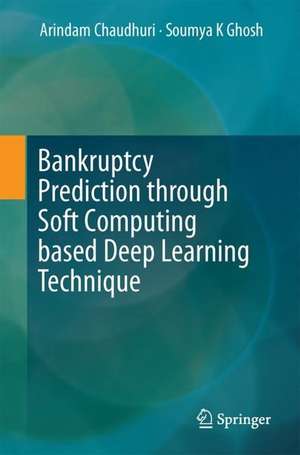Bankruptcy Prediction through Soft Computing based Deep Learning Technique
Autor Arindam Chaudhuri, Soumya K Ghoshen Limba Engleză Paperback – 13 dec 2017
The bookalso highlights the fact that misclassification can result in erroneous predictions leading to prohibitive costs to investors and the economy, and shows that choice of cut-off point and sampling procedures affect rankings of various models. It also suggests that empirical cut-off points estimated from training samples result in the lowest misclassification costs for all the models. The book confirms that FRTDSN-HRB achieves superior performance compared to other statistical and soft-computing models. The experimental results are given in terms of several important statistical parameters revolving different business cycles and sub-cycles for the datasets considered and are of immense benefit to researchers working in this area.
Preț: 323.80 lei
Preț vechi: 404.74 lei
-20% Nou
Puncte Express: 486
Preț estimativ în valută:
61.96€ • 64.85$ • 51.57£
61.96€ • 64.85$ • 51.57£
Carte tipărită la comandă
Livrare economică 31 martie-14 aprilie
Preluare comenzi: 021 569.72.76
Specificații
ISBN-13: 9789811066825
ISBN-10: 9811066825
Pagini: 108
Ilustrații: XVII, 102 p. 59 illus.
Dimensiuni: 155 x 235 x 14 mm
Greutate: 0.18 kg
Ediția:1st ed. 2017
Editura: Springer Nature Singapore
Colecția Springer
Locul publicării:Singapore, Singapore
ISBN-10: 9811066825
Pagini: 108
Ilustrații: XVII, 102 p. 59 illus.
Dimensiuni: 155 x 235 x 14 mm
Greutate: 0.18 kg
Ediția:1st ed. 2017
Editura: Springer Nature Singapore
Colecția Springer
Locul publicării:Singapore, Singapore
Cuprins
Introduction.- Need of this Research.- Literature Review.- Bankruptcy Prediction Methodology.- Need for Risk Classification.- Experimental Framework: Bankruptcy Prediction using Soft Computing based Deep Learning Technique.- Datasets Used.- Experimental Results.- Conclusion
Notă biografică
Arindam Chaudhuri: Arindam Chaudhuri is currently a Data Scientist at the Samsung R & D Institute Delhi, India. He has worked in industry, research and teaching in the field of machine learning domain for the past 16 years. His current research interests include pattern recognition, machine learning, soft computing, optimization and big data. He received his MTech and PhD in Computer Science from Jadavpur University, Kolkata, India and Netaji Subhas University, Kolkata, India in 2005 and 2011 respectively. He has published 2 research monographs and over 40 articles in international journals and conference proceedings. He has served as a reviewer for several international journals and conferences.
Soumya K Ghosh: Soumya K Ghosh is currently a Professor at the Department of Computer Science Engineering at the Indian Institute of Technology Kharagpur, India. His current research interests include pattern recognition, machine learning, soft computing, cloud applications and sensornetworks. He received his MTech and PhD in Computer Science Engineering from the Indian Institute of Technology Kharagpur, India in 1996 and 2002 respectively. He has over 25 years of experience in industry, research and teaching. He has published 2 research monographs and over 100 articles in international journals and conference proceedings. He has served as a reviewer for several international journals and conferences.
Soumya K Ghosh: Soumya K Ghosh is currently a Professor at the Department of Computer Science Engineering at the Indian Institute of Technology Kharagpur, India. His current research interests include pattern recognition, machine learning, soft computing, cloud applications and sensornetworks. He received his MTech and PhD in Computer Science Engineering from the Indian Institute of Technology Kharagpur, India in 1996 and 2002 respectively. He has over 25 years of experience in industry, research and teaching. He has published 2 research monographs and over 100 articles in international journals and conference proceedings. He has served as a reviewer for several international journals and conferences.
Textul de pe ultima copertă
This book proposes complex hierarchical deep architectures (HDA) for predicting bankruptcy, a topical issue for business and corporate institutions that in the past has been tackled using statistical, market-based and machine-intelligence prediction models. The HDA are formed through fuzzy rough tensor deep staking networks (FRTDSN) with structured, hierarchical rough Bayesian (HRB) models. FRTDSN is formalized through TDSN and fuzzy rough sets, and HRB is formed by incorporating probabilistic rough sets in structured hierarchical Bayesian model. Then FRTDSN is integrated with HRB to form the compound FRTDSN-HRB model. HRB enhances the prediction accuracy of FRTDSN-HRB model. The experimental datasets are adopted from Korean construction companies and American and European non-financial companies, and the research presented focuses on the impact of choice of cut-off points, sampling procedures and business cycle on the accuracy of bankruptcy prediction models.
The book alsohighlights the fact that misclassification can result in erroneous predictions leading to prohibitive costs to investors and the economy, and shows that choice of cut-off point and sampling procedures affect rankings of various models. It also suggests that empirical cut-off points estimated from training samples result in the lowest misclassification costs for all the models. The book confirms that FRTDSN-HRB achieves superior performance compared to other statistical and soft-computing models. The experimental results are given in terms of several important statistical parameters revolving different business cycles and sub-cycles for the datasets considered and are of immense benefit to researchers working in this area.
The book alsohighlights the fact that misclassification can result in erroneous predictions leading to prohibitive costs to investors and the economy, and shows that choice of cut-off point and sampling procedures affect rankings of various models. It also suggests that empirical cut-off points estimated from training samples result in the lowest misclassification costs for all the models. The book confirms that FRTDSN-HRB achieves superior performance compared to other statistical and soft-computing models. The experimental results are given in terms of several important statistical parameters revolving different business cycles and sub-cycles for the datasets considered and are of immense benefit to researchers working in this area.
Caracteristici
Highlights the latest research on deep learning integrated with hierarchical Bayesian statistics for bankruptcy prediction. Presents the mathematical framework of the prediction model in a very lucid manner. Experiments use real-world datasets and the results support the theoretical hypothesis. A valuable resource for postgraduate students and researchers in deep learning and mathematical finance. The proposed prediction model can be applied to any skewed real life dataset.
